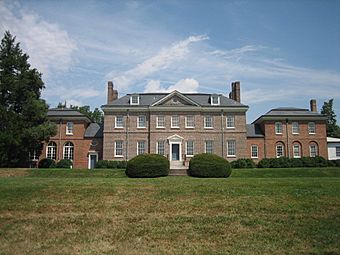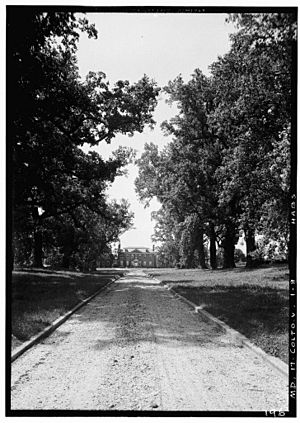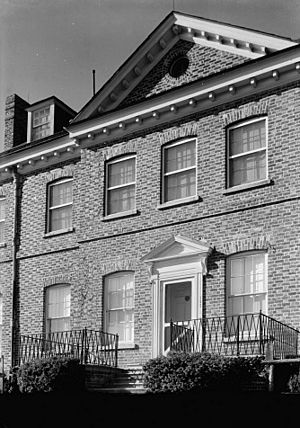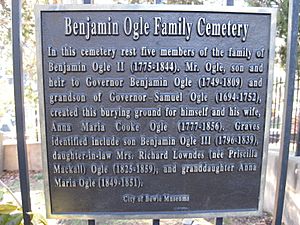Belair Mansion (Bowie, Maryland) facts for kids
Quick facts for kids |
|
|
Belair Mansion
|
|

Front of Belair Mansion, August 2007
|
|
| Location | 12207 Tulip Grove Drive in Bowie, Maryland, USA |
|---|---|
| Nearest city | Bowie, Maryland |
| Area | Architecture, Landscape Architecture, Politics/Government, Social History |
| Built | c. 1745 |
| Architect | Benjamin Tasker Sr. (original) Delano & Aldrich (1914 expansion) |
| Architectural style | Georgian plantation house |
| NRHP reference No. | 77001520 |
| Added to NRHP | September 16, 1977 |
The Belair Mansion is a historic house located in Bowie, Maryland, United States. Built around 1745, it's a beautiful Georgian style plantation house. It was once the home of Samuel Ogle, who was the Governor of Maryland when it was a British colony. Later, another Maryland governor lived here too. Today, the mansion is recognized as a special historical place on the National Register of Historic Places.
Belair is famous for being the only large colonial estate where race horses were bred for over 300 years! This estate played a big part in developing thoroughbred horse racing in America. It's one of only two stables ever to raise two horses that won the Triple Crown of Thoroughbred Racing. Both the mansion and its nearby stables are now museums. The City of Bowie operates them, so visitors can learn about their amazing history.
Contents
Belair Mansion: A Look Back in Time
How Belair Began
The land where Belair Mansion stands was first a 500-acre property called Catton. It was granted by the Calvert family, who founded the Maryland Colony, in 1681. Over time, the land changed hands. In 1721, after a new survey, the property grew to 1,410 acres and was given the name Belair.
The Ogle Family's Story
Samuel Ogle became the Governor of Maryland in 1732. He was given money to build a home, but he wasn't in a hurry. In 1737, he bought the Belair land with a partner, Benjamin Tasker Sr.. Soon after, Ogle bought Tasker's share and became the sole owner. In 1739, Ogle married Anne Tasker, Benjamin's daughter.
Building a Grand Home
In 1740, Governor Ogle went to England. He left Benjamin Tasker Sr. in charge of building a new house at Belair. When Ogle returned in 1747 with his wife, their new home was ready. It was considered "the grandest in the region." Ogle also brought two famous English racehorses, Queen Mab and Spark, gifts from Lord Baltimore. This was the start of the famous Belair Stud horse breeding program.
When Samuel Ogle passed away in 1752, his 3-year-old son, Benjamin Ogle, inherited Belair. Benjamin Ogle grew up and became a friend of George Washington. Washington even visited Belair in 1773. Benjamin Ogle later became the Governor of Maryland in 1798.
Life at Belair After the Revolution
In 1798, Belair was a large and important plantation. It had a mansion, a greenhouse, a kitchen, a poultry house, and stables. It was known as one of the best-equipped plantations in the area. Benjamin Ogle continued to run the estate and its horse farm until he died in 1809. His son, Benjamin Ogle II, took over.
After Benjamin Ogle II died in 1844, his sons divided the estate. George Cooke Ogle kept the mansion. However, a new law in 1864 freed all enslaved people in Maryland. This changed how plantations like Belair operated. Without its workforce, Belair faced financial difficulties.
In 1871, the property had to be sold to pay off debts. It was bought by the family of a mortgage holder, William Henry Tayloe. Rosalie Ogle, Benjamin Ogle II's youngest sister, had a special agreement to live in the mansion as long as she was single. She eventually received a cash settlement, and the Ogle family's long ownership of Belair ended in 1877.
New Owners and Horse Racing Fame
After the Ogle family, Belair changed hands several times and fell into disrepair. In 1898, a wealthy banker named James T. Woodward bought the mansion and 371 acres. He invested a lot of money to repair Belair. He died in 1910 without marrying.
The Woodward Family's Legacy
James T. Woodward's nephew, William Woodward Sr., inherited Belair in 1910. He expanded the mansion in 1914, adding two wings. This expansion was designed by famous architects Delano & Aldrich. William Woodward Sr. also bought more land, growing the estate and developing the Belair Stud into a world-renowned horse breeding operation.
In 1923, trainer Sunny Jim Fitzsimmons joined Belair. He helped the Belair Stud achieve incredible success, including two Triple Crown champions. Only one other stable has ever matched this feat! William Woodward Sr. passed away in 1953, and his son, William Woodward Jr., took over.
William Woodward Jr. was also a big fan of horse racing. He ran Belair for a short time.
Belair Becomes a Community Hub
By the time William Woodward Jr. died, the estate had grown to 2,280 acres. In 1957, Levitt and Sons bought the property. They used the mansion and stables as offices while they built a new suburban housing development called "Belair at Bowie."
In 1964, Levitt sold the mansion and some land, including the Ogle family cemetery, to the City of Bowie for just $1. The mansion became the city's City Hall. In 1978, the city hall moved to a new location.
Belair Mansion Today: A Museum for All
Today, the Belair Mansion is located at 12207 Tulip Grove Drive in Bowie, Maryland. It is owned by the City of Bowie and operates as a museum. The nearby Belair Stable Museum is also a museum. Both the mansion and the stables are listed separately on the National Register of Historic Places, inviting everyone to explore their rich history.
Architectural Style of Belair Mansion
Belair Mansion was designed in the Palladian architecture style, which means it focuses on symmetry and balance. The original house has two long sides with a main door in the center and an equal number of windows on each side. It has four chimneys that serve nine fireplaces inside.
The front of the house, facing south, has seven sections. The middle sections are taller and have a triangular roof part called a pediment. The back of the house also has a pediment. The bricks on the front are laid in a special pattern called Flemish bond, while other sides use English bond. The house has a strong, decorative cornice (a molding along the top of a wall) all around.
The main entrance on the south side has a pediment supported by decorative brackets. The entrance on the north side has a beautiful portico (a porch with columns) with Ionic columns.
The Ogle Family Cemetery
On the mansion grounds, there is a small cemetery. It holds the grave of Benjamin Ogle II, who died in 1844 or 1845.
Other family members buried here include:
- Benjamin Ogle II's wife, Anna Maria Cooke Ogle (1777–1856)
- Benjamin Ogle III (1796–1839), who faced financial difficulties.
- Priscilla Mackall Ogle (1825–1859)
- Anna Maria Ogle (1849–1851)
More to Explore
- Foxhill Park
- Belair Stable Museum
- Belair Stud




